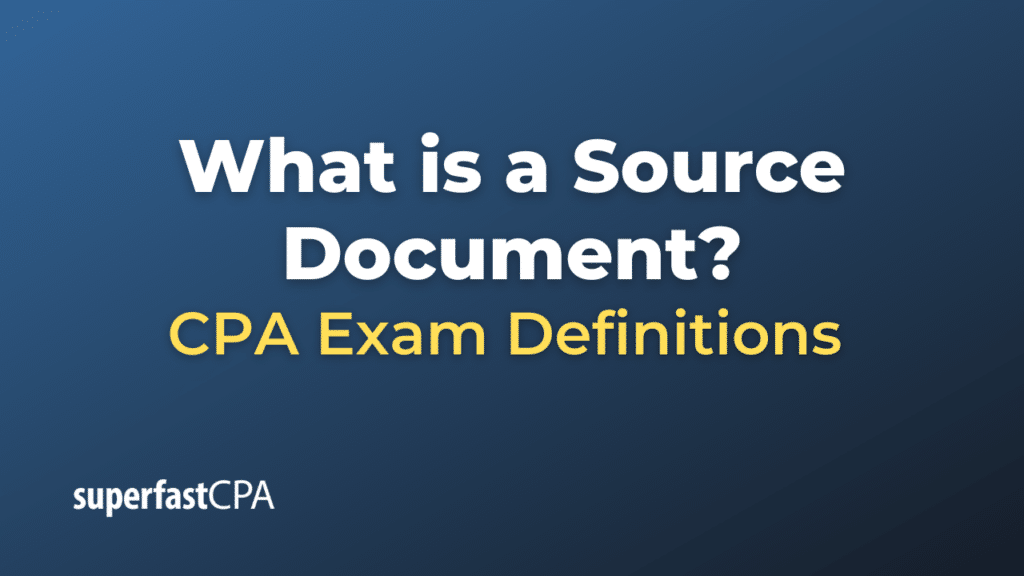Source Document
A source document, in accounting, refers to the original document that contains the details of a business transaction. It serves as evidence that a particular transaction occurred and provides the necessary information to record the transaction in the company’s accounting system. These documents are crucial for maintaining accurate records, preparing financial statements, and conducting audits.
Examples of source documents include:
- Invoices: Sent to customers detailing the products or services sold, their prices, and the total amount owed.
- Receipts: Given to customers as evidence of payment, typically for cash transactions.
- Purchase Orders: Prepared by a buyer when ordering goods from a supplier.
- Sales Orders: Received from customers, indicating their intent to purchase specific items in specified quantities.
- Bank Statements: Provided by banks, detailing all transactions that have occurred in a particular account over a specific period.
- Payroll Records: Detailing employees’ pay rates, hours worked, deductions, and net pay.
- Bills: Received from suppliers or service providers, indicating an amount owed for goods or services received.
- Credit Notes: Sent to customers or received from suppliers to correct or adjust the amount of an invoice.
- Debit Notes: Issued in situations where a short payment has been received or there’s a need to increase the amount owed by a customer.
- Timesheets: Used by employees to record the number of hours they’ve worked over a particular period.
- Expense Reports: Used by employees to claim reimbursements for business expenses they’ve incurred.
- Cheques: Used to make payments. A cancelled cheque can act as proof that a payment was made.
- Contracts: Detailing the terms and conditions of a business arrangement or agreement.
- Shipping and Delivery Documents: Such as packing slips, which provide evidence of goods dispatched or received.
In the accounting process, these source documents are used as the starting point for recording transactions in journals. From journals, the transaction information is then transferred to ledgers, and ultimately, it helps in the preparation of the company’s financial statements. Keeping these documents organized and easily accessible is crucial for audit purposes, financial transparency, and ensuring accuracy in the accounting records.
Example of a Source Document
Let’s walk through an example of how a source document is used in a typical business transaction.
Scenario: Purchase of Office Supplies
Company: XYZ Enterprises
Transaction: XYZ Enterprises decides to purchase office supplies from a local vendor, ABC Supplies.
1. Purchase Order (Source Document)
- XYZ Enterprises creates a purchase order to buy:
- 50 boxes of pens
- 20 reams of paper
- 10 packs of printer cartridges
- The purchase order states the item descriptions, quantities, and agreed prices.
- This document is sent to ABC Supplies as a formal request for the items.
2. Delivery and Goods Receipt Note (Source Document)
- ABC Supplies delivers the ordered items to XYZ Enterprises.
- Along with the items, ABC Supplies provides a Goods Receipt Note (or packing slip) that lists the items delivered.
- An employee at XYZ Enterprises checks the received items against the purchase order to ensure everything ordered has been delivered.
3. Invoice (Source Document)
- After confirming the delivery, ABC Supplies sends an invoice to XYZ Enterprises, billing them for the items.
- The invoice contains details of the products, quantities, unit prices, total amount, and payment terms.
4. Payment and Receipt (Source Document)
- Upon receiving the invoice and verifying it against the goods receipt note and the purchase order, XYZ Enterprises processes payment.
- If XYZ Enterprises pays in cash, ABC Supplies will give them a receipt as a proof of payment. If XYZ Enterprises pays by cheque or electronic transfer, the bank statement or the cheque stub can act as a source document for this payment.
- Based on these source documents, the accounting department at XYZ Enterprises will record the transaction in the company’s accounting system.
- Debit: Office Supplies Expense (for the total amount of the invoice)
- Credit: Cash or Accounts Payable (depending on whether the payment was made immediately or will be made later)
This example illustrates how a series of source documents (purchase order, goods receipt note, invoice, and receipt) accompanies a single transaction, ensuring that every step of the process is documented and verifiable. Each of these documents will be filed and stored by both companies for future reference, audits, and to resolve any potential disputes.












